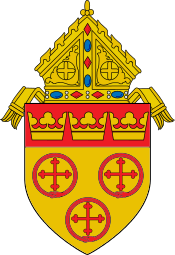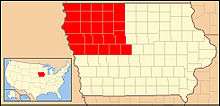Roman Catholic Diocese of Sioux City
| Diocese of Sioux City Dioecesis Siopolitanensis | |
|---|---|
 The coat of arms of the Diocese of Sioux City | |
| Location | |
| Country | United States |
| Territory | 24 Counties in the Northwest quadrant of Iowa |
| Ecclesiastical province | Dubuque |
| Metropolitan | Michael Owen Jackels |
| Coordinates | 42°30′02″N 96°24′23″W / 42.50056°N 96.40639°WCoordinates: 42°30′02″N 96°24′23″W / 42.50056°N 96.40639°W |
| Statistics | |
| Area | 14,518 sq mi (37,600 km2) |
| Population - Total - Catholics |
(as of 2014) 502,800 100,300 (19.9%) |
| Parishes | 111 |
| Information | |
| Denomination | Catholic Church |
| Rite | Roman Rite |
| Established | January 15, 1902 (116 years ago) |
| Cathedral | Cathedral of the Epiphany |
| Patron saint | Our Lady of Guadalupe |
| Current leadership | |
| Pope | Francis |
| Bishop | R. Walker Nickless |
| Emeritus Bishops | Lawrence Donald Soens |
| Map | |
 | |
| Website | |
| www.scdiocese.org | |
The Roman Catholic Diocese of Sioux City (Latin: Dioecesis Siopolitanensis) is the Roman Catholic diocese for the northwestern quarter of the US state of Iowa. The diocese comprises 24 counties in northwestern Iowa, and it covers an area of 14,518 square miles (37,600 km2). The See city for the diocese is Sioux City. It is a suffragan see of the Archdiocese of Dubuque. The cathedral parish for this diocese is the Epiphany. R. Walker Nickless was ordained as bishop of Sioux City on 20 January 2006.
History
_from_SE_1.jpg)
On 24 July, 1900, Pope Leo XIII issued a papal bull appointing John J. Keane, former Bishop of Richmond and the first rector of the Catholic University of the Catholic University of America, as Archbishop of Dubuque. This same document provided for the creation of a new diocese by the separation of twenty-four counties in northwestern Iowa from the Archdiocese of Dubuque. The Catholic population of the diocese was about 50,000 people who spoke English and/or German.[1]
The first bishop of the Diocese of Sioux City was Irish-born Philip Joseph Garrigan. Garrigan grew up in Lowell, Massachusetts and was ordained 11 June, 1870 the Provincial Seminary of New York at Troy. After a short term as curate of St. John's Church, Worcester, Massachusetts, he was appointed director of the Troy seminary for three years, and later pastor of St. Bernard's Church, Fitchburg, Massachusetts. In the fall of 1888 he was appointed the first vice-rector of the Catholic University at Washington, D. C., during the tenure of Keane as rector. Garrigan held the position of vice-rector for fourteen years. He was serving as vice-rector when he was named Bishop of Sioux City on 21 March, 1902, and consecrated at the see of his home diocese, Springfield, Massachusetts, on 25 May of the same year, by the Right Rev. T.D. Beaven, and on 18 June took possession of his see.[1]
Bishop Garrigan designated the not yet completed St. Mary’s Church, in the center of the city, as the Cathedral Church of the Diocese. With permission from the Holy See he renamed the church the Cathedral of the Epiphany. Bishop Garrigan carried on an extensive visitation of all the parishes of the diocese. Garrigan died 14 October 1919, and his auxiliary bishop, Edmond Heelan, was appointed his successor.[2]
Heelan was born in County Limerick, Ireland[3] and ordained to the priesthood on June 24, 1890. He was rector (1893-1897) of St. Raphael's Cathedral in Dubuque from 1893 to 1897. He was pastor of Sacred Heart Church in Fort Dodge, Iowa when named Auxiliary Bishop of Sioux City. He received his episcopal consecration on April 8, 1919 from Archbishop James Keane. As an auxiliary, he served as rector of the Cathedral of the Epiphany. Heelan was named the second Bishop of Sioux City on March 8, 1920. During his nearly thirty-year tenure, he guided the diocese through the Great Depression and World War II, and greatly expanded Catholic education. He died 20 September 1948 at age 80.
Heelan was succeeded by his coadjutor, Joseph Maximilian Mueller. Born in St. Louis, Missouri,[3] Mueller studied at Pontifical College Josephinum in Columbus, Ohio and was ordained on June 14, 1919. He then served as rector of St. Peter's Cathedral in Belleville, Illinois. He was named a Domestic Prelate in 1939. On August 20, 1947, Mueller was appointed Coadjutor Bishop of Sioux City, Iowa. Upon the death of Bishop Edmond Heelan, Mueller became succeeded the third Bishop of Sioux City. During his 22-year-long tenure, he presided over a period of great expansion in the diocese. He built several new schools, churches, and other parish facilities. He also attended all four sessions of the Second Vatican Council between 1962 and 1965. After reaching the mandatory retirement age of 75, Mueller retired as Bishop.
Upon the resignation of Bishop Mueller, Pope Paul VI appointed native Iowan, auxiliary bishop Frank Henry Greteman, the fourth Bishop of Sioux City. Greteman held a Licentiate of Sacred Theology from the Pontifical North American College in Rome, and a Licentiate of Canon Law from the Catholic University of America. He was named a Domestic Prelate in 1953, and vicar general of the Sioux City Diocese in 1965.[3] On April 14, 1965, Greteman was appointed Auxiliary Bishop of Sioux City. The primary focus of his episcopate was Catholic education. Upon reaching the mandatory retirement age of 75, Greteman submitted his letter of resignation to Pope John Paul II in December 1982. The Pope accepted the resignation of Bishop Greteman's resignation as ordinary and named him apostolic administrator.
On June 15, 1983, John Paul appointed Msgr. Lawrence D. Soens, pastor of St. Mary Church, Clinton, Iowa, as the fifth ordinary of the Diocese of Sioux City. His ordination and installation were held Aug. 17, 1983, at the Cathedral of the Epiphany, Sioux City. During his period of tenure, a number of programs were established or expanded.[2] In 1997 Soens requested a coadjutor bishop be named and on August 19, 1997, Pope John Paul II named Msgr. Daniel DiNardo from the Diocese of Piitsburgh. Soens' resignation as Bishop of Sioux City was accepted by the Holy See on November 28, 1998, and he was succeeded by his coadjutor, Bishop Daniel DiNardo.
Bishop DiNardo succeeded as Bishop of Sioux City on Nov. 28, 1998. In 2004 Bishop DiNardo left to become the coadjutor bishop of the Diocese of Galveston-Houston in Texas. Msgr. Roger Augustine was named the administrator of the Diocese of Sioux City.[2]
On Nov. 10, 2005, it was announced that Pope Benedict XVI had appointed Msgr. R. Walker Nickless of Denver as the seventh bishop of the diocese. His episcopal ordination was held on Jan. 20, 2006 at Nativity of Our Lord Jesus Christ Church in Sioux City. On Nov. 23, 2015, Bishop R. Walker Nickless granted permission to the Ministry Institute of Christ the Servant to identify as a Catholic institute.[4] The Ministry Institute is affiliated with Briar Cliff University.
In 2016, the Diocese announced plans to consolidate forty-one parishes due a shortage of priests and decreased attendance at Mass. Parishes being consolidated would become oratories for prayer services, funerals, and weddings but weekly Masses would not be held. Most of the parishes affected are in rural areas. With more priests reaching retirement age, the proposal is intended in part to reduce the workload of those left, that they remain healthy and not overworked.[5]
The Diocese of Sioux City is a suffragan see of the Archdiocese of Dubuque.
Bishops
Bishops of Sioux City
- Philip Joseph Garrigan (1902-1919)
- Edmond Heelan (1920-1948)
- Joseph Maximilian Mueller (1948-1970)
- Frank Henry Greteman (1970-1983)
- Lawrence Donald Soens (1983-1998)
- Daniel N. DiNardo (1998-2004), appointed Coadjutor Bishop and later Coadjutor Archbishop and Archbishop of Galveston-Houston (elevated to Cardinal in 2007)
- R. Walker Nickless (2005-present)
Coadjutor bishops
- Thomas Lawrence Noa (1946–1947), appointed Bishop of Marquette
- Joseph Maximilian Mueller (1947–1948)
Auxiliary bishops
- Edmond Heelan (1918–1920), appointed Bishop of Sioux City
- Frank Henry Greteman (1965–1970), appointed Bishop of Sioux City
Diocesan priests who became bishops
- Dennis Marion Schnurr, appointed Bishop of Duluth and later Archbishop of Cincinnati
High schools
- Bishop Garrigan High School, Algona
- Bishop Heelan Catholic High School, Sioux City
- Gehlen Catholic High School, Le Mars
- Kuemper Catholic High School, Carroll
- St. Edmond High School, Fort Dodge
- St. Mary's High School, Remsen
- St. Mary's High School, Storm Lake
Closed schools
- Spalding Catholic High School, Granville
References
- 1 2 Garrigan, Philip. "Sioux City." The Catholic Encyclopedia Vol. 14. New York: Robert Appleton Company, 1912. 18 November 2017
- 1 2 3 "History", Diocese Of Sioux City
- 1 2 3 Curtis, Georgina Pell. The American Catholic Who's Who, vol. VII, 1947, Walter Romig, Grosse Pointe, Michigan
- ↑ Letter of Bishop Nickless to Brandon Harvey, November 23, 2015
- ↑ Gstalter, Morgan. "Catholic Diocese of Sioux City to Close 41 Parishes.", Des Moines Register, February 28, 2016
![]()
External links
| Wikisource has the text of the 1913 Catholic Encyclopedia article Sioux City. |